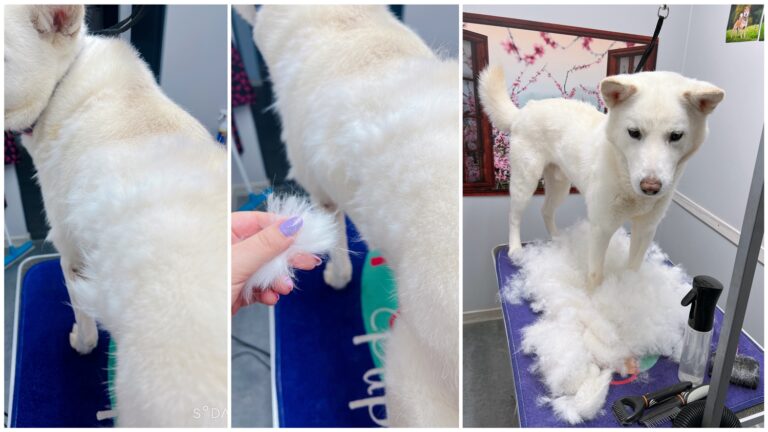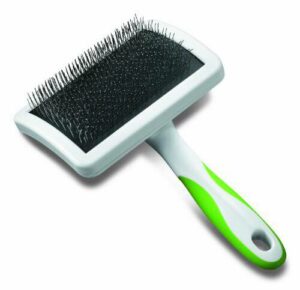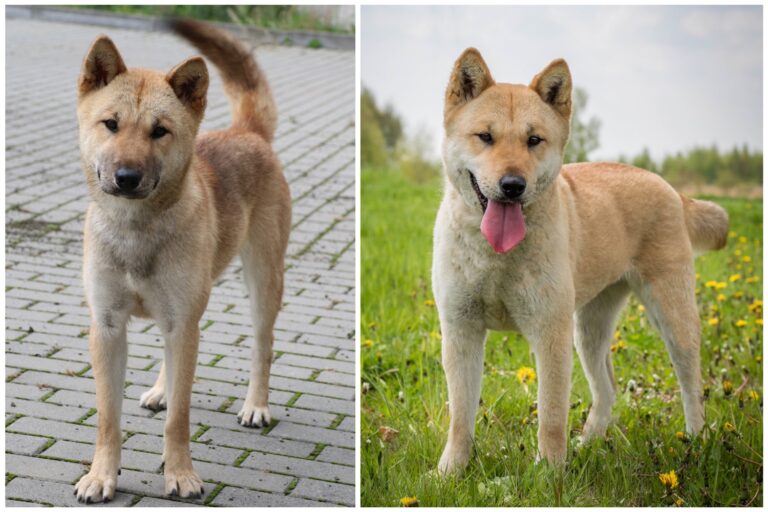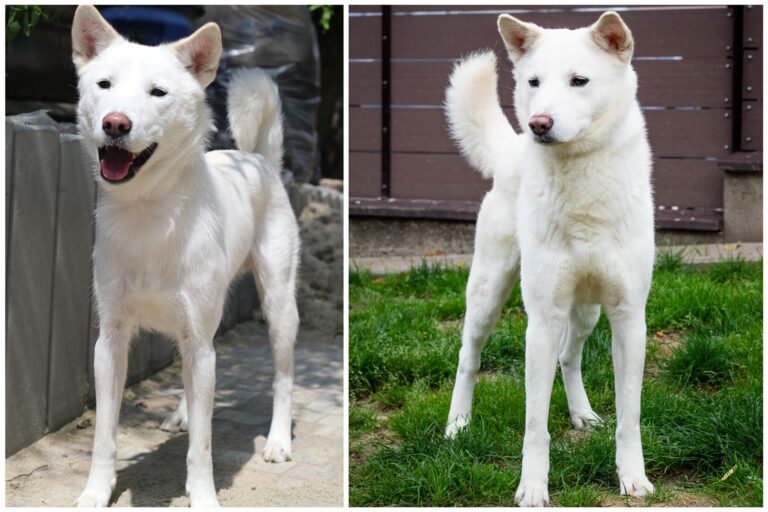Does the Jindo shed a lot?
COAT
Hair: The Korea Jindo Dog has a double coat. Undercoat is soft,
dense, light in colour, but sufficient to support the outercoat.
Outercoat is stiff and stands somewhat off body. Comparing with the
hair of the body, the hair on head, legs and ears is shorter and the hair
on the neck, withers, back and rump is longer. The hair on tail and
back of thighs is longer than on the rest of the body.
FCI-Standard N° 334
We already know that Jindo is a double coated breed – it has a thick and soft undercoat and a rougher and longer outer coat.
The shedding process most often begins in spring, when the dog sheds its thick winter coat, and in autumn, when it replaces its summer fur with warmer, denser. First the entire undercoat comes out, and then the outer coat.
During this time, it is necessary to brush our dog more often and, unfortunately, vacuum the apartment more often. The undercoat is very light, so with a slight breeze it will rise and settle on armchairs, furniture, in a cup of coffee or in soup, not to mention our clothes. Interestingly, the undercoat rarely attaches to the dog itself 😉
Usually, Jindos do not require frequent brushing, but during shedding they need to be brushed once or twice a week. Of course, nothing will happen to him if we turn on the lazy mode and wait until the hair removes itself. Balls of dog glitter will then be everywhere, but it’s nothing a good vacuum cleaner can’t handle.
However, if it is warm, we should relieve the animal by getting rid of dead hair faster so that it does not overheat and to prevent frequent scratching, which can be caused by a large amount of hair falling out.
A very good idea is to bathe your dog during this period, which will be great for getting rid of dead skin and allowing the hair to fall out faster. At the same time, it will moisturize the skin, and the massage itself will stimulate the growth of new hair.
How and with what to brush your dog?

In addition to accustoming the dog to brushing from a puppy’s age, it is important what tools to use so that the combing goes smoothly and does not cause any damage, e.g. scratching the skin, pulling out hair, etc. This process should be a pleasure, each grooming procedure should be performed gently, praising the pet for that he is the best, patient dog.
When you go to a pet store, you will probably see many types of brushes; from expensive metal ones that supposedly remove all dead hair, to cheaper plastic ones.
A slicker brush, a metal comb and a hook trimmer work best for Jindo.
- Slicker brush is a popular option for both dogs and cats. Compared to a human hairbrush, which usually consists of widely spaced pins, a poodle’s hairbrush has rows of tightly arranged wires. Although made of metal, they are slightly curved so as not to scratch the dog’s delicate skin. This is a great choice for a Jindo coat that consists of a dense undercoat and needs a tool that will cut through a lot of fur without too much pressure and won’t injure the skin while getting rid of tangles.

- A metal comb will come in handy when the undercoat falls out in clumps.
- The hook trimmer has a wide tooth spacing that easily removes dead undercoat, combs out tangles (e.g. on the tail), and at the same time smoothes the outer hair. This is a great option for dogs that have a really thick undercoat. The teeth of the comb are sharpened from the inside, thanks to which they perfectly cut matted hair without damaging healthy hair. At the same time, the teeth are rounded at the ends, so that combing our dog is completely safe.

Does the environment influence fur quality?
Definitely yes, the environment in which the dog lives has a large impact on the quality of its coat. Those who spend more time outdoors and in the fresh air than in a warm apartment are in noticeably better condition.
Jindo has lived on a Korean island for hundreds of years, guarding his territory, game and owner’s belongings. He lived in the yard, often accompanying his master on hunts, and had to cope both in summer and in the cold winter. Then, in order to survive, it acquired thick fur, which created a protective barrier against hypothermia. Also in summer, the double-layered fur provided excellent protection against overheating.
This is still the case today, which is why dogs living in a warm apartment may tend to have less abundant coats or shed more often.
“Awfulness phase”
This is a term used mainly by dog breeders and refers to shedding during the juvenile period, when the dog completely changes its coat from puppy to adult. This is the time of the ugly duckling – sometimes a really ugly duckling 😱 – because the dog becomes almost bald, its skin is visible, it may look like it is malnourished, and it is also a time of certain disproportions in development, which is even more visible without fur.
This process takes longer than standard shedding, up to 3-4 months. Many inexperienced owners panic that something is wrong with their dog’s health, or they despair over the less attractive appearance of their dog.
The “awfulness phase” usually happens once, although I know of dogs that went through it twice.
Whether our dog will have lush and thick adult fur or slightly less will depend on predispositions (genes), environment, diet and health problems.

